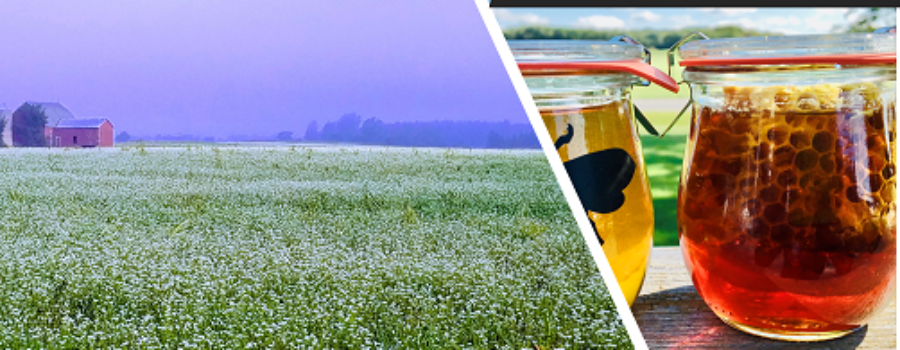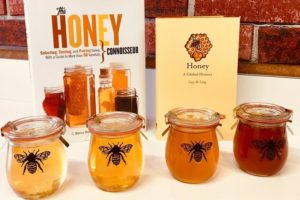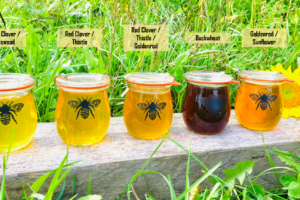Dark cherries, cola, chocolate, earthy, molasses, all are words to describe the complex flavor profile of buckwheat honey. In our 2019 Honey Report we describe how when we bottle a jar of honey, it captures a very specific moment and flavor in time that details what was blooming on and around the farm. One of our goals at Firefly Fields’ apiary is to do exactly that and seize the sweetness of the landscape. Unlike many commercial beekeepers that chase different blooms hauling honey bees from Michigan to California to North Dakota across a single year, our bees stay put; living exclusively on the farm. Our goal is to share with you the sweet experience of the unique diversity in honey flavors that can be supported and cultivated on and around our family’s certified organic farm in Nashville, Michigan.

An oldie, but a goodie
Buckwheat has a rich history with people and maintains a stronghold in many traditional dishes in Asia and eastern Europe. Recent archaeobotany evidence connects people in Northern China with the plant dating to around 4000 B.C.E. From this origin point it is believed to have gradually made its way to the Middle East and Europe. European colonists brought the prominent fruit (used like a grain) to America peaking in popularity around the 1860s; however, by the 1960s modern agriculture pushed this once common, rotational crop into severe decline and obscurity. To give you a sense of scale, today more than 90 million acres of land are planted with corn, and only 60,000 acres of land are planted with buckwheat. Buckwheat is one rare commodity, making buckwheat honey even more rare.
In health food circles, buckwheat has been making a mini comeback. It’s gluten free and a complete protein, containing all nine of the essential amino acids that humans do not produce naturally and must consume through food. Buckwheat is also rich in fiber, B vitamins, and is an excellent source of magnesium, copper and manganese. So, it makes sense that honey made from the bright flowers and deep red pollen of these delicious berries would also yield a highly nutritious honey higher in antioxidants.

Rare harvest
While 2020 has proven to be an unforgettable year for human kind; on the farm, 2019 was a record tough year for the books. In our 40th year of operation (2019), the spring and early summer were so exceptionally wet that for the first time in our family’s history we were unable to plant beans or corn. So many farmers were in the same boat, either unable to plant or with sunken spirits as their baby seeds drowned out in the field. So, a lot of cover crops were planted later in summer to keep the fields in working condition. A bittersweet honey harvest would later be realized as buckwheat was one of those cover crops perfect for the wet and rough field conditions. Over the course of 4 weeks in September of 2019, bees on three hives harvested an excess of 7.25 gallons of buckwheat honey.


Highlighting flavor
We moved a few hives to a protected area on the farm that was in close proximity to the buckwheat field (less than 20 yards away). Walking into the apiary on heavy nectar flow days smelled like wet saddle leather with chocolate, malty molasses-like sweetness. On a still, warm morning Virginia would go out and lay under the hive entries to watch the bees. From the view below the entry, the massive bee populations formed ‘conveyor belts’ overhead flying in organized action directly to the buckwheat blooms and then back into the hives with loads of nectar and pollen. A peak inside the honey supers would reveal this peculiar reddish tint to the nectar, evidence of buckwheat’s red pollen that gives the color to honey.
Harvesting, bottling, and tasting the cured buckwheat honey is pure joy. Buckwheat honey in the sun’s light reveals a burnt amber glow. From a distance, it almost looks dark brown. When you open the jar to take a whiff, it brings you right to the farm on a warm sunny day sitting on a blanket in the shade about to feast on something bold and intense. Buckwheat honey is sweet, but not as super sweet as some of the other honeys. An intense burst of dark red cherries hits the front of your tongue, and a multitude of other flavors unfold. Tastes linger in and out from the front of your mouth to the back of your throat – leaving a tickle. Hints of chocolate and molasses as well as malty, nutty tastes and even earthy, wood phase in and out of this tasty buckwheat treat.
Pairs Well With – vanilla ice cream, grits, old-fashioned (whiskey) cocktails, goat cheese, ricotta, Greek yogurt, oatmeal, buckwheat cakes and sausage, scones, biscuits, elderberry tea, gingerbread cookies, mead making, and more pairings to be discovered.

What do you think? Do you have other ideas for how to pair this bold varietal honey? Let us know in the comments.






1 Comment
Leave your reply.